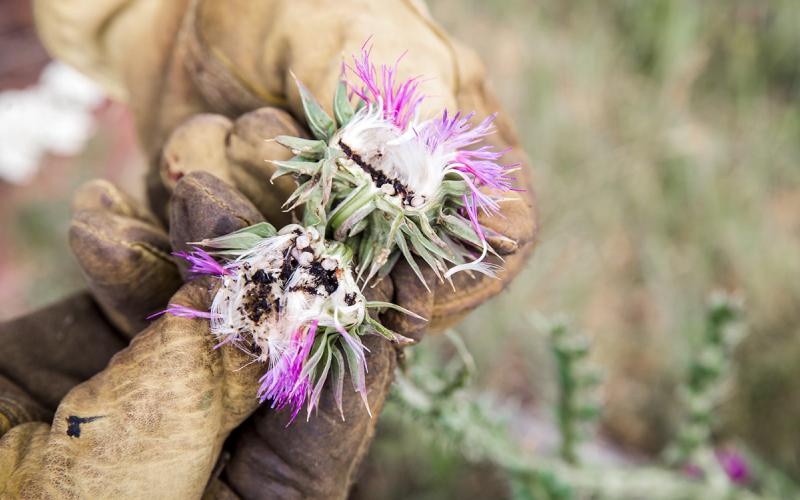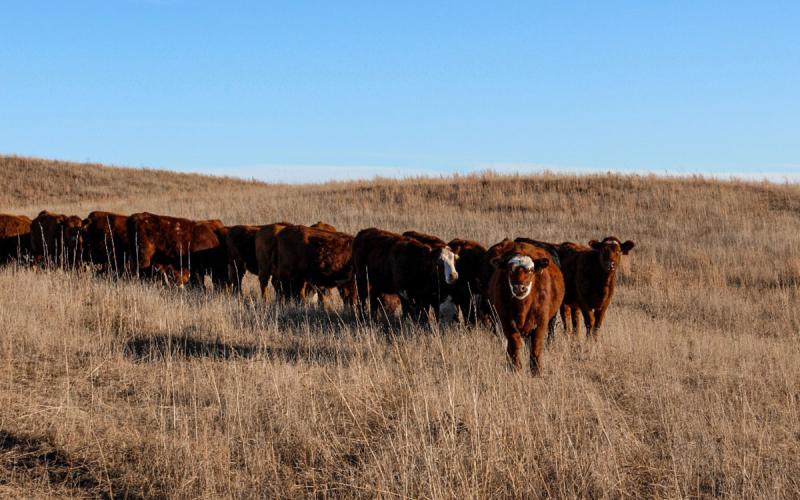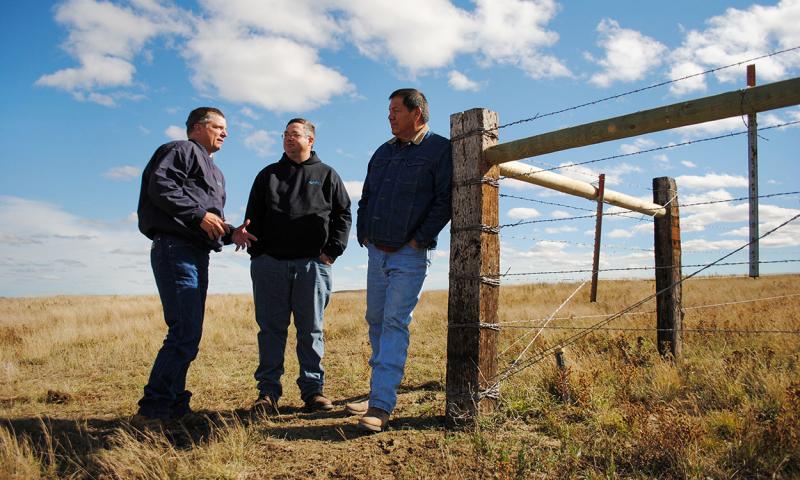
Fall is the time to begin planning for spring prescribed fire, regardless of what type of fuels you plan to burn. There are generally three primary components to a successful burn, including: 1) burn unit preparation, 2) burn planning and 3) burn implementation.
Burn Unit Preparation
To begin, we will examine the first step, which is preparing the burn unit. Unit preparation is integral to the planning process, as the burn will be much improved if the planner has a true ‘feel’ for the burn unit, including its boundaries, topography, fuel load and potential hazards. This knowledge is best gained by visiting and even preparing the unit ahead of time. However, if there is uncertainty about the best layout for a burn unit, one should seek outside advice from a trusted resource before investing heavily into unit preparation or disking. Once the unit is prepared, a very accurate unit map can be produced, which is a very important part of any prescribed fire plan.
Fuel load
In South Dakota, it is generally recommended that you have at least one full season of rest prior to burning (especially in grazed pastures). Rest allows for the best-possible establishment of a fuel bed, which will allow for a complete and functional burn. We lose about one-half of the biomass left in a grassland over the winter due to breakage and wind erosion, so it is critical to enter the winter months with a full ungrazed/unhayed fuel load. Generally speaking, more fuel is better, as it allows you to extend the window of opportunity to conduct the fire later into the spring, as the dry fuel load from the previous year will provide adequate fuel, even as the grassland greens through late-May. Without adequate fuel, the time spent preparing and planning for a fire can be wasted, and disappointment with the fire effects is likely.
Preparing Firebreaks
Firebreak preparation is essential to successful fire management. There are essentially two main categories of firebreaks: hard and soft.
Hard Firebreaks
A hard firebreak is essentially one that simply will not burn and that will not allow fire to cross under normal circumstances. Examples of hard firebreaks are gravel roads, wide streams and rivers, tilled areas with mineral soil, etc. The U.S. Department of Agriculture’s Conservation Reserve Program (CRP) does allow a producer to till the edges of a potential burn unit, as long as there is a conservation plan and a restoration plan in place for the tilled boundary. Tilling the edges of native pastures or other native grasslands is never recommended, as it destroys the native sod base, opening up the land for infestation of weeds and likely reducing long-term productivity. Where land is covered by an easement or another similar conservation program contract, tilling may violate contract conditions.
- Tilling traditional and no-till field edges: When burning in the vicinity of established crop fields, it is advisable to work with neighbors to ensure field edges are adequately disked or otherwise worked to the point that fire cannot spread across the previous year’s residue. This is advisable even on the edges of no-till fields, as this small investment will ensure that the fire does not escape the unit boundaries and consume the very valuable residue remaining across the entire field.
Soft Firebreaks
A soft firebreak will generally suppress the spread of fire due to a reduction in fuel load. Examples of soft firebreaks can be: mowed lines, grazed areas, narrow watercourses, pasture roads, two-track roads or any fuel change that decreases the rate of fire spread, thus giving the manager an opportunity to suppress the fire if necessary. When installing soft breaks by mowing, there are a few critical steps to consider:
- Timing: Mow when the grass is drying down in the fall. September through December create good opportunities, especially after the first hard freeze.
- Ground conditions: Be careful. Wetter areas can often be mowed after frost or when the ground is firming up. Consider how wet the area will be in the spring. A soft firebreak in the spring can create many hazards with vehicles getting stuck, so plan firebreak locations appropriate to anticipated spring conditions.
- Topography: When possible, keep your firebreaks low on the landscape. Avoid ridges and hilltops in favor of flat or gentle slopes on the bottom of hills or near natural drainages when possible. However, if you have established trails and roads on hilltops and ridges, they can be utilized as well. If the low ground or drainages has significantly heavier fuel loads that make installation of firebreaks difficult, placement on ridges and hills may be a better option. One must always consider the predominant wind direction that he/she intends to use for the burn when making firebreak placement decisions.
- Surroundings: Tie firebreaks into standing water, roadways or tilled fields if available, leaving no standing fuel between your firebreak and the water. Cattails and other vegetation can be easily smashed down with all-terrain vehicles (ATV), utility terrain vehicles (UTV) or light tractors. Additional vegetation can be mowed after freeze-up if wet ground is an issue.
- What to avoid: Avoid wet areas and give wide birth to areas with heavy fuels, such as brush piles, cattails sloughs or heavy grass loads. Try to keep your firebreak in light fuels.
- Removal of mowed litter: It is very important to remove as much litter and duff from firebreak lines as possible. Side delivery mowers (even finishing the line with a lawn mower) are great options. Raking and baling are also options. Never leave raked and windrowed litter on the firebreak, because it will create a hazard during the fire event. If the litter isn’t baled, simply rake it out 30-or-40 yards into the standing grass of the fire unit. Many times, when you rake cut litter into standing grass, the windrow will eventually fall apart and spread out.
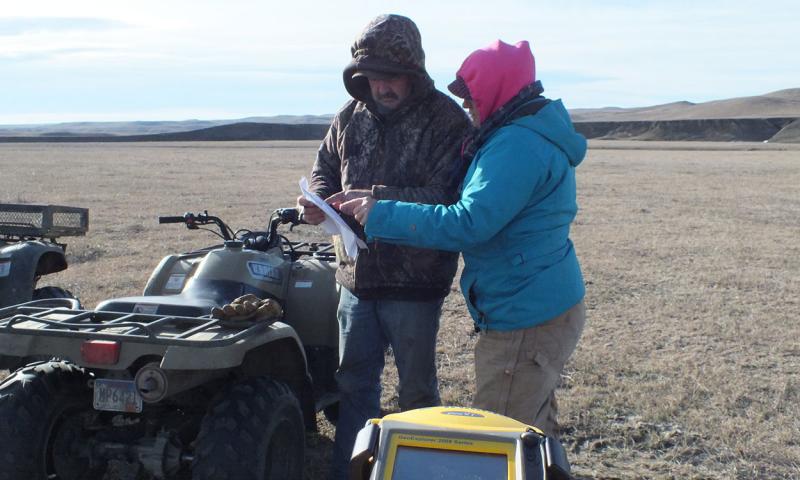
Burn Planning
Goals and Objectives
It is important that fire not be planned as ‘fire for the sake of fire.’ Goals and objectives are critical to understanding where, when and how to accomplish the fire project. An example of appropriate goals and objectives would be a pasture burn where one is targeting control of cedar trees. The management goal may be to reclaim 30% of the pasture area lost to cedar trees, while the burn objective may be to kill all cedar trees under three-feet tall.
Goals and objectives do not have to be perfect, but they are an important part of the process in order to plan the appropriate fire timing and weather conditions that will meet these needs. For instance, with the goals and objectives stated above, one may need to consider warm, dry early-spring conditions. Similarly, if the goal is to burn 30% of a planted grass habitat that is not encumbered with a simple objective of consuming 50% of the dead grass, this can be accomplished under much different weather and timing conditions than the cedar burn, such as late-May, when the fire is more controllable. Seek outside assistance from local experts or experienced neighbors when planning goals and objectives.
Land ‘Type’
First, it is very important to understand well the ‘type’ of land you intend to burn. Generally, grassland burns fall into two major categories: 1) land that is encumbered by an agreement, easement or contract and 2) land that is not (unencumbered). We will also discuss burn objectives in this section.
Encumbered Land
When planning a burn, it is important to know if the land is encumbered by any other type of agreement, written or oral, that would suggest another entity has an interest or say in the management decisions. Examples of encumbrance may include, but are not limited to: leases (written or oral), share agreements, USDA management contracts (such as CRP, Environmental Quality Incentives Program (EQIP), Wetlands Reserve Program (WRP), Conservation Stewardship Program (CSP), etc.), easements or any other such agreement where a second-or-third party has some ‘rights’ to the management. If encumbrances are present, it is important to begin discussions with the affected parties very early in the burn planning process to ensure that all parties are in agreement with the management action and that any permits or plans are properly documented.
Generally, CRP is a common program where prescribed burning is utilized for specific management objectives. Fall is the time to make local USDA service centers aware of burn plans on CRP, especially if one desires to seek USDA financial or planning assistance. Waiting until the last minute generally creates delays and unnecessary stress on the parties involved. The CRP is a USDA Farm Service Agency (FSA) program with practices administered through Natural Resources Conservation Service (NRCS). Fire plans generally need county committee approval. There are a few steps one should be aware of for prescribed fire:
- Prescribed burning must be written into the conservation plan. Burning can be added to conservation plans, but now is the time to start that process.
- Burning must be within the establishment or mid-term management designated years.
- Electronic and paper copies of the approved South Dakota NRCS/FSA fire plan with instructions are available through local USDA service centers. Plans are also available to download at the South Dakota NRCS range and pasture page.
- Fire planning assistance is available through trained staff at many USDA service centers.
- CRP burns must be completed prior to May 1. Pasture burns should be conducted in May in most cases.
Other USDA contract lands, U.S. Fish and Wildlife Service easements or other encumbered properties may require similar notifications and permissions. It is likely that in some cases, encumbered lands may require an archeological assessment and may have certain periods of the year where fire is or is not allowed, such as the primary bird nesting season. Again, to ensure a timely fire project, starting the process early is important.
Unencumbered Land
Generally, this category would include properties that are owned in fee title and do not have any other secondary relationship. A great example is a typical pasture owned and operated by an individual with no contracts or easements. In this case, the landowner need not receive outside permission and can burn this land whenever weather conditions are conducive to the prescribed goals or objectives of the fire. Landowners who lease land to others generally would not need any type of permission from their lessee. However, including your lessee in your management plans ensures that both parties are involved in cooperative planning and goal setting for the health of the pasture.
Planning and Implementation Assistance
- Visit the South Dakota NRCS range and pasture page to view instructional materials related to prescribed burning, including the South Dakota burn plan template.
- Take advantage of late fall and early winter to notify your local fire department of burn intentions, especially if you intend to ask for their assistance and to coordinate any cost share paperwork that may be necessary.
Safety and Liability
- Always notify the sheriff, area fire departments and neighbors of your intentions, and keep them posted as the burn project progresses from planning to implementation.
- It is generally advisable to notify your insurance company if you intend to participate in fire activities.
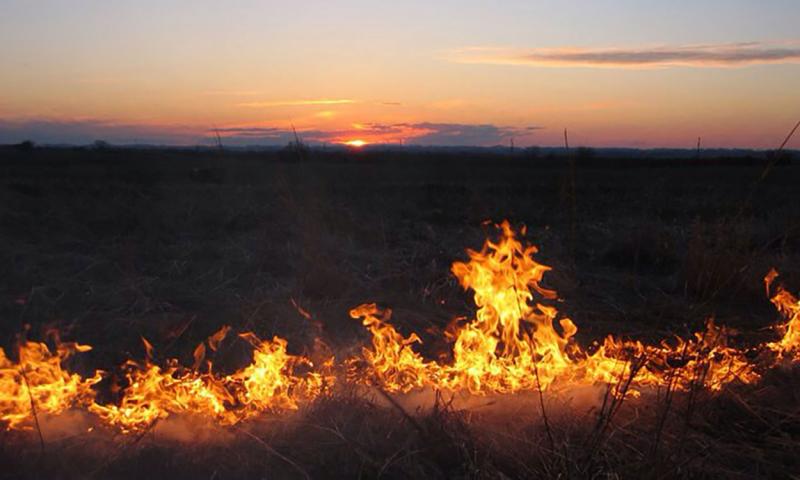
Burn Implementation
The ability to implement a safe and effective burn is influenced by an appropriately prepared burn unit and a well-written burn plan. However, similar to sports, preparation only gets you so far, and you must be willing to execute the game plan and recognize when and where a plan may need to be modified.
Revisiting Fire Breaks and Fuel Loads
Burn unit preparation should be completed well ahead of implementing the burn plan and striking a match. A key step in this process is for the landowner, or person in charge of the burn, to visit and re-visit the ‘game plan,’ both physically and mentally. Simple critical thinking and discussion with others regarding how the burn may progress can provide important opportunities to identify obstacles, hazards or problem areas well ahead of the fire event. Physically visiting the burn unit several times prior to the burn will also provide opportunities to identify if and where improvements or adjustments to the plan may be warranted.
Example Scenarios
An example may be a situation where there is a plan to burn a CRP field next to a neighbor’s no-till wheat field. The CRP burn unit might have been prepared by mowing around the perimeter to protect the wheat stubble. In the spring however, it is discovered that the neighbor has disked the stubble and planted a new row crop. In this scenario, the burn plan may need to change to take advantage of this new development in ground conditions. What was a burn edge that required additional resources to protect the wheat stubble, has now become a very simple line where very few resources will be required on the day of the burn. In this scenario, it is likely that the preferred wind direction may now be opposite of what was originally planned, allowing for a reduction or a shift in personnel and equipment. These changes should be noted on the written burn plan and implemented accordingly.
A second scenario may be that, due to a wet spring, there is an opportunity to take advantage of a flowing creek that was dry during the fall. Monitoring the burn unit in the weeks and days leading up to the burn date will allow for planned changes to be communicated to the burn team prior to implementation. Monitoring the fuel load in the burn unit is also important. It is not uncommon during a windy South Dakota winter for nearly half of your planned fuel load to break-off and blow away. Conversely, in wooded areas, fuel arrangement can change. For instance, a blowdown of trees near the burn perimeter could complicate the burn implementation plan and may require delaying the burn or the need for additional personnel and equipment to prevent the fire escaping from the planned unit.
Burn Weather
A fire plan should reflect the best possible wind direction to ensure the safety of burn personnel and neighboring property. The landowner, or designated burn boss, should begin monitoring weather patterns early in the spring and keep an eye on the various weather options that exist for the burn. In most cases, the wind and weather parameters that have been pre-identified in the burn plan should be adhered to. However, if ground conditions change, or if burn perimeters become more or less defensible, one can justify adjustments in wind and weather parameters.
Just as important as the day-of-burn weather is the post-burn weather forecast. For example, if the burn plan calls for a 10-mph south wind to minimize the chance of fire escaping to the north into a neighbor’s property, monitoring the weather forecast for the likelihood of a south wind is the first step. However, if the next day’s weather forecast calls for a 20–30 mph north wind with gusts up to 40 mph, the burn may need to be delayed to diminish the chance of embers blowing out of the burn unit the next day when no resources will be on site to protect the neighbor.
Meeting Objectives
It is important not to plan or implement ‘fire for the sake of fire.’ There is generally a fair amount of investment into fire preparation and planning, and as burn opportunities present or disappear, it can be tempting to implement a fire under less-than-ideal conditions. An obvious critical mistake is to initiate a fire when weather conditions or available personnel or equipment resources are clearly contrary to the written prescription. A subtler mistake is to initiate the fire under allowable prescription parameters, but when goals and objectives have little chance of being achieved due to poor fuel load, wet fuel, or other such conditions.
Personnel and Equipment Management
It is critical to ensure resources and equipment are maintained and ready before implementing a burn. People are important to success, and good communication prior to the fire will ensure smooth operations during the fire. Maintaining direct contact with the team as the burn date approaches and visiting the entire fire unit as a team prior to the burn are critically important steps that allow personnel to create a mental ‘base map’ of the burn unit and surrounding areas. Not only does it increase the team comfort level, but it allows for interaction, questions and suggestions on potential improvements to the fire implementation plan. Further, pre-visiting the unit dramatically decreases confusion and disorientation among individuals that may not be familiar with the land. When fire and smoke are on the ground, people can become easily disoriented, especially in stressful situations. Equipment should be staged and ready well ahead of the planned start time, and all safety equipment and personal protective equipment should be in place (water, first aid, etc.), including communications, prior to beginning operations.
